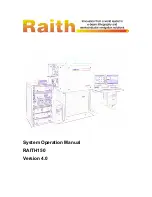
January 2016, Rev. 1
CAM216/16 IOM
Doc. Number: ECM-402-0116
62
Section 10: Miscellaneous
Miscellaneous
Section 10: Miscellaneous
10.1
Stroking the Actuator
The actuator can be stroked (opened or closed) via the following techniques:
1.
The hand wheel
2.
The Local Push Buttons
3.
Remotely using other Host, means such as Emerson’s DCMlink software
10.1.1
Using the Hand wheel (On/Off Function Type)
To use the hand wheel to stroke the actuator while the selector switch is in Remote/
Auto position, the actuator must be commanded to its "Stop" state via the Actuator
Command parameter. Normally, if the hand wheel is turned while the actuator is
in control (Auto), and the movement causes the actuator to move more than the
Deadband value from its commanded position, the actuator will compensate and
attempt to move the actuator to its original commanded position, given that the
Setpoint tracking option is selected. Using the "Stop" command will cause the actuator
to stop processing position, thereby allowing the user to move the actuator with the
hand wheel. Alternately, the LOR selector switch on the Local Control Panel can be
moved to the “Local/Manual” or “OFF” position. The actuator electronics no longer has
control of the actuator. It may then be moved using the Hand wheel.
NOTE:
If the selector switch is in the Remote/Auto position and the Actuator Command is changed
from "Stop", the actuator will immediately start moving to the commanded position depending
on the control source (see the following sections).
1.
Send a "Stop" command to the device Actuator Command parameter via the Discrete
Output function block.
2.
Move the actuator with the hand wheel.
3.
Command the actuator to the desired position.
10.1.2
Using the hand wheel (Positioning Function Type)
To use the hand wheel to stroke the positioning actuator, the LOR selector switch
should be moved to the “Local/Manual” or “OFF” position. If the hand wheel is turned
while the actuator is in control, and the movement causes the actuator to exceed its
Deadband value, the actuator will compensate and attempt to position the actuator to
the originally commanded position. Placing the selector switch in the "Local/Manual”
or “OFF” position will remove control from the actuator thereby allowing the user to
move the actuator with the hand wheel.
NOTE:
When the selector switch is moved to the "Remote/Auto" position, the actuator will
immediately start moving the actuator to the commanded position depending on the
control source (see the following sections).
10.1.3
HART Interface Procedure
When in remote mode (Auto) and the actuator is in a normal state, use SV (Setpoint) to
command the actuator at desired position (0 to 100%), as long as the actuator is in the
network control mode.
















































